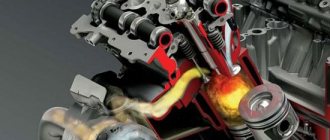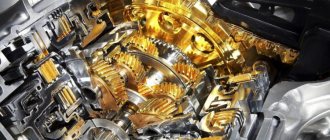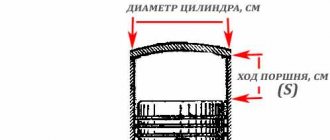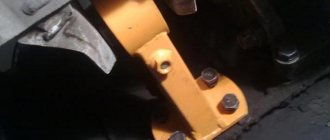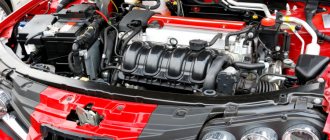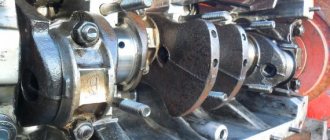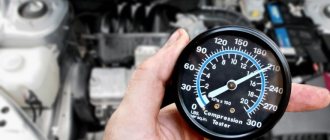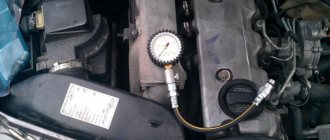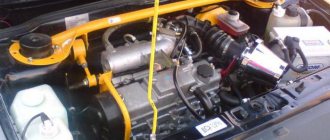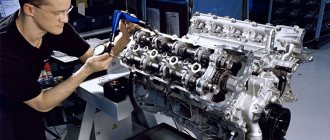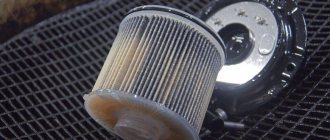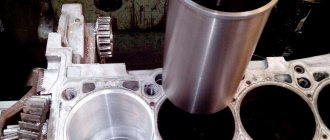Surely every car enthusiast, when driving on the highway or overtaking another car, thought: oh, if only the power unit of a racing car were on the “swallow”. Today there are many options on how to achieve the desired result in terms of engine power and throttle response. The problem is solved using both partial and complex methods.
Along with the usual boosting of the unit, the implementation of which comes down to replacing the standard equipment for the intake and exhaust of gases, pistons, camshaft and other mechanisms, they use turbines for an atmospheric engine. The work leads to the desired result, however, the distinctive feature is the laboriousness of the process, high cost and ambiguous results.
Another method of changing the characteristics of a car is an engine swap. The technology avoids some of the disadvantages inherent in other processes. However, there are shortcomings, let's try to figure it out.
Toyota Altezza with 2JZ-FSE swap engine installed:
What is swap in games?
3. “Swap, switch” ( swap
, switch) is a special function with which a player can give up his turn to choose a hero to another player.
To do this, you need to press the appropriate button. ... Being in the meta means that the hero is now relevant in high-level play
.
Interesting materials:
How to find out who owns a mailbox? How to find out who Likes whom on VK? How to find out who was on a plane flight? How to find out who forwarded a story on Instagram? How to find out who the Internet provider is? How to find out who viewed my profile in telegram? How to find out who viewed a profile on Viber? How to find out who watched a video and liked it? How to find out who blocked you on WhatsApp? How to find out who the owner of a car is?
Difficulties of the procedure
Despite the seemingly simple operation, engine swap brings some difficulties to the owner. Depends on what the final goal is pursued by the car enthusiast. If the operation is carried out by replacing the unit with a similar engine, no difficulties arise. But, as a rule, most of the work is aimed at increasing the power and performance of the engine, and that’s another conversation.
In order to increase torque and power, they install an engine whose dimensions hardly fit into its standard place. Therefore, a lot of work is being carried out to re-equip the car, strengthen the body, gearbox, change the electrical system, and so on.
The issue that needs to be resolved is the weight of the new motor. Powerful units are usually heavier than standard engines. Additional weight will require changes to the vehicle's mounts, suspension, and steering. Improperly calculated weight distribution will make the vehicle difficult to control. In addition, the unit will increase the load on the brakes, which will lead to wear and failure.
From time to time, there are options for replacing outdated units with technologically advanced, economical, but difficult to implement. Such a replacement will entail a reconfiguration of the electronics, and possibly the installation of new electronic systems, sensors, and units.
Although a swap is not a full-fledged tuning, the process entails modifications and changes in the design of the vehicle. An exception is replacing the engine with a similar unit. The work requires responsibility and professionalism, as it poses a danger when a car drives onto a public road.
Lada Niva car with 2JZ engine installed:
Tips and tricks
As you can see, at first glance, swapping an engine for tuning a car at the initial stage may seem like a more attractive option. However, in practice, installing turbocharging becomes a much more profitable and less problematic solution.
The fact is that any modifications to a vehicle must be registered by law, but there are usually much fewer problems with an unregistered turbine on an atmospheric internal combustion engine. Even if traffic police officers discover an installed boost during inspection, the vehicle is often not sent for examination.
If the owner is interested in a swap, the Japanese JZ series engine (1JZ-GE, 1JZ-GTE, 2JZ-GE, 2JZ-GTE) serves as a clear demonstration of the ability to successfully implement the task. In practice, these engines and other reliable options in the CIS are often installed on BMW models and popular cars known for their excellent handling and sporty character.
How to register a modified engine
If the owner of a vehicle makes changes to the engine or changes the shape and color of the body, he must register all changes made.
It has long been abolished to check the engine during technical inspection, but if the characteristics of the swapped engine have changed, then it must be registered with the MREO.
If you do everything according to your mind, then the correct order is this:
- Even before replacing the engine, submit an application for replacing the internal combustion engine of the vehicle to the registration authorities. Provide them with a technical passport.
- They may require a certificate from a car service station stating that the motor was purchased legally.
- Prove that the vehicle design is suitable for the new engine.
- Go through an examination and receive a document stating that the new internal combustion engine is suitable.
- After all the work has been completed, come to the traffic police and register, showing the car.
If, when submitting an application, it is determined that a new powerful engine will create a danger for the driver and passengers, then permission to change the power unit will not be issued.
Conclusion
If you do an internal combustion engine swap, the control can change greatly. Therefore, after all repair work, it must be tested with caution, on empty streets or in the forest.
Increase in power up to 15 hp. will not greatly affect the driving dynamics of the car. But, an increase in power from 30 hp. will lead to a change in the car’s handling and to wear of the components associated with the internal combustion engine (box, suspension, etc.). And if the car has an automatic transmission, it will be difficult to follow the driving rules if the engine power is greatly increased, because an automatic transmission was installed from the factory for a lower-power engine.
Another important point: if the car is very old, the suspension and body are “shaky” (rotten), then it is not recommended to install a more powerful engine than it was.
My personal opinion: I would not do such an amount of work for a swap, but would sell this car and buy a more powerful one if necessary.
Swap: how to change the engine to a more powerful one and not go broke
Let's say you have a favorite car. Everything is fine with her, and everything suits her, except for one thing - the engine. You can’t sleep, you need someone else. But you don’t want to change your car. Or, let’s say, this model with the desired engine was not produced... Well, there is only one way out: you need a “swap” - replacing the engine. By the way, in English the word swap literally means a transaction or exchange.
This operation is complex, costly and requires extensive paperwork. But it is quite possible and interesting. This story is about how this happens and what surprises await brave car owners.
The task can vary greatly in terms of the scope of work, the number of custom parts, the degree of intervention in the design of the car, and so on, but is usually limited to preserving the original car body with minimal alterations. Quite extreme options are also possible, with the installation of longitudinally mounted engines in front-wheel drive cars with rear-wheel drive, with a serious modification of the engine shield, prototyping of the ends of the car to lighten and expand the space for the engine, but these are rather unique projects for changing the car, and not the actual replacing only the power unit.
Why is this necessary? Sometimes - in order to get a more powerful car, which has regular “horses” registered in its title. In general, according to the law, the replacement of a power unit is supposed to be recorded by the traffic police, but the practice is such that this is neglected. Inspectors, even at MREO, cannot always distinguish engines by eye, and there is no need to talk about those who are on duty on the streets. It is after the “swap” that, most often, you can see inscriptions like “power 300 horsepower, PTS 120” in the advertisement for sale. We will not comment on the moral and legal side of such actions and will simply state a fact.
The second option is simply installing a more powerful engine with registration in the traffic police. Just imagine, there are those who don’t want problems with the law and find it easier to pay an annual tax.
The third option is replacement as the old motor wears out or because of its inherent problems. So, a very common “victim of a swap” is the Mazda RX-8 , where a “regular” one is installed instead of the original rotary piston engine.
The simplest of all complex ones
Perhaps the simplest “swap” is replacing the motor that was installed on this model. Sometimes not for this configuration, or only on cars before or after restyling, but it was installed regularly at the factory.
As we have already said, such a “swap” is relatively simple. The motor is mated to one of the standard gearboxes, installed on the standard mounts, if necessary, with the replacement of the subframe, the necessary wheel drives and sometimes hubs, a cooling system are installed on it, a standard electric “braid” of the engine compartment, a dashboard, and an engine control unit are connected (ECU)... In general, all mismatched parts are replaced with the required ones from cars with such an engine.
Despite its apparent simplicity, the operation turns out to be expensive, especially if there is no so-called “donor” - a machine from which these parts are removed. Buying the necessary components at retail and new is usually more expensive than buying a motor or even a whole car. Moreover, the work may stall due to some trifle, such as other brake system pipes, or stumble due to the need to replace the steering rack, ABS unit, front panel and other “unexpected” things.
The volume of alterations may turn out to be unexpectedly large in this case, so before such an operation it is worth seriously working with the catalogs for the machine and finding out exactly which parts will have to be replaced. And there is room for creative efforts, because it is not always necessary to adhere to factory specifications; deviations are possible.
And even if some completely unique configurations do not appear, the next owner may be quite puzzled by such a “config”. The car after the “swap” will in the future require ordering spare parts not “from the catalogue”, and the craftsmen may be quite surprised at the unusual combinations.
Examples of such modifications include the installation of a c20xe engine in an Opel Vectra A, which is not equipped with one, the implantation of an M52 engine in various BMWs in the E36 body, or a more serious version of the same BMW, but with an engine from an M3. Once again repeating the Opel-BMW combination, you can add the installation of the x18xe1 unit in the small Opel Tigra B (instead of the standard x16xel of a smaller volume), the “transplant” of the Opel x30xe into the Vectra B and the serious “lightweight” V8 M60 into the BMW model in the back of the E34.
Level up
A little more complicated - the “swap” option for the motor is structurally similar, but still not installed on the car. For example, on a simple Opel Vectra B you can put under the hood a c20xe engine with 150 horsepower or a 204 horsepower c20let with Vectra A and Calibra, instead of x20xev (by the way, the c20let can also be installed on Corsa with Tigra). They have the same cylinder block, and the gearbox and drive are compatible, as are the motor mounts.
Or a more modern option: instead of the z22se, you can install a turbocharged B207 engine from a Saab or Vectra C, these engines also have the same cylinder block and are installed with the same gearbox and mounts. Unlike replacing it with a standard engine, you can’t get by with just installing parts “on paper” - even if you want, you’ll have to install new wiring, new sensors, a new control unit and connect it with other standard electronics, weld a new exhaust system and much more. You will often have to look for a “compatible” gearbox if the engine is noticeably more powerful than before. Well, there are a lot of “little things”, the number of which can go off scale.
Continuing the theme of “swap” in German cars, it is worth mentioning the installation of BMW M60/M62 engines on three-ruble cars in the E36/E46 body, as well as the Mercedes E113 engine on the brand’s W202-W203 model. Well, for dessert, you can go to the “Japanese” and add the universally adored 1JZ-GTE and 2JZ-GTE engines for cars such as the Lexus IS200-IS250, Mark II/Corona, Supra and other rear-wheel drive Toyotas and Lexuses.
